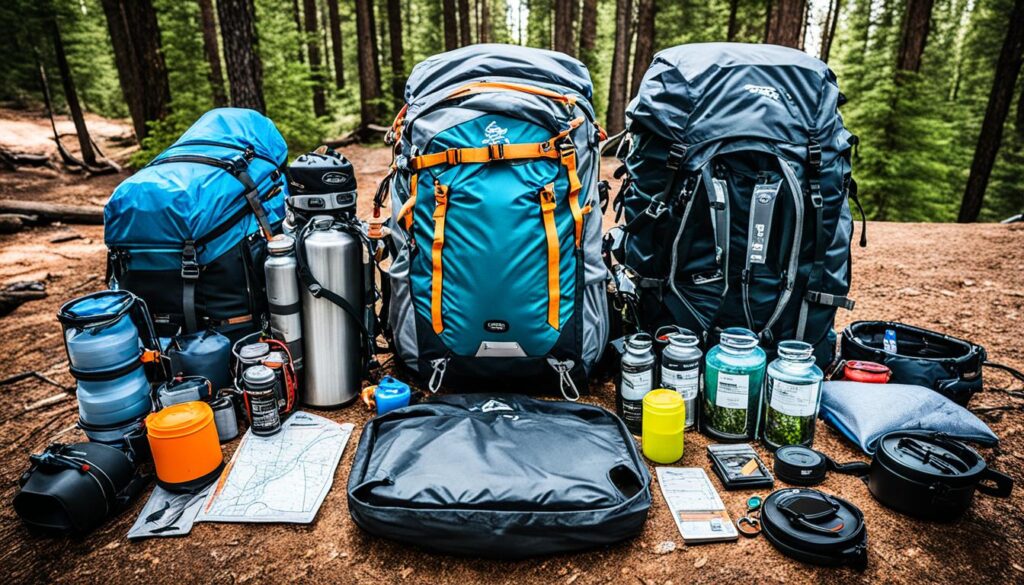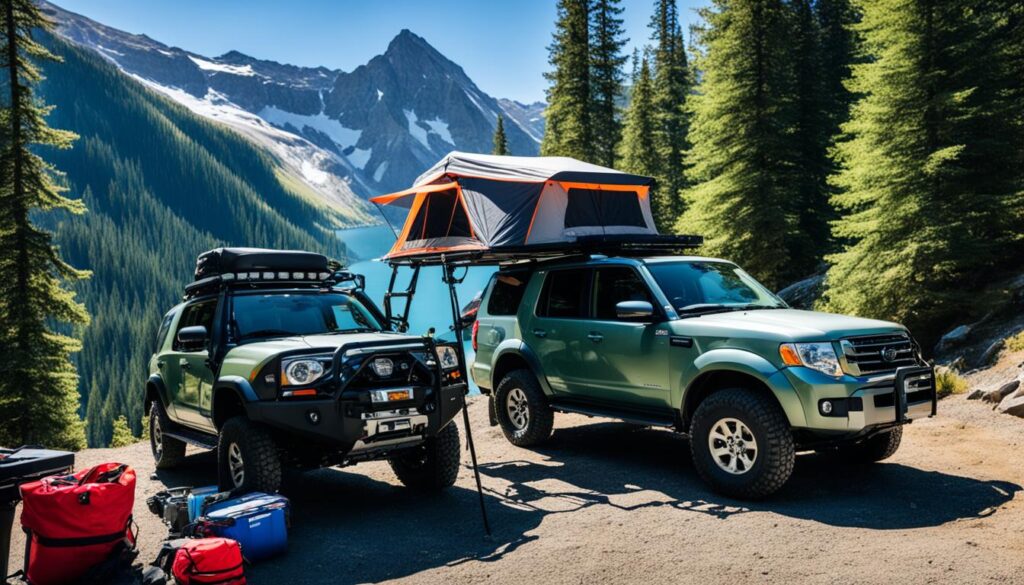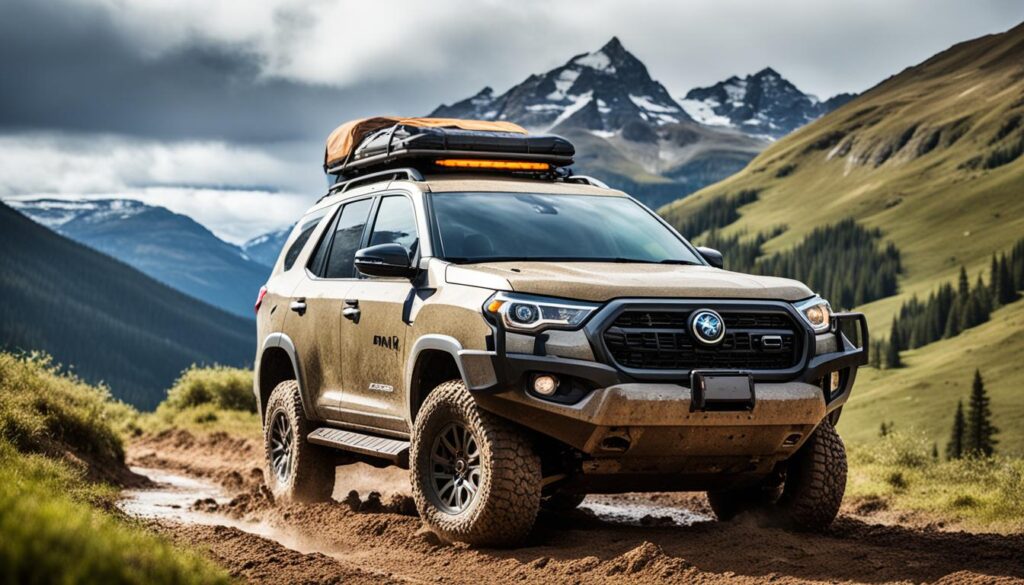Have you ever dreamt of embarking on an unforgettable adventure, exploring untamed nature, and experiencing the thrill of off-road exploration? If so, overlanding might be the perfect travel style for you. But how exactly do you start overlanding? Is it something that only experienced adventurers can do? Let’s unravel the mysteries of overlanding and discover how beginners can dive into this exciting world.
Overlanding is not just about reaching a specific destination; it’s about embracing the journey itself. This self-sustained form of travel allows you to immerse yourself in nature, drive through challenging terrains, and uncover hidden gems that are inaccessible to most travelers. But before you set off on your overlanding adventure, there are a few things you need to know.
Key Takeaways:
- Overlanding is a self-sustained form of travel that involves exploring off-road terrain.
- It’s important to have a mindset of self-reliance and be prepared for the challenges and risks involved.
- Overlanding has gained popularity in recent years and is popular in various parts of the world.
- Preparing the right gear and vehicle is crucial for a successful overlanding trip.
- Choosing the right overlanding routes and gradually progressing to more challenging ones is important for beginners.
Contents
Essential Overlanding Gear Checklist
When preparing for your overlanding adventure, it’s crucial to have the right gear to ensure a safe and enjoyable experience. From vehicle preparation to personal camping essentials, here’s a checklist of overlanding gear you’ll need:
Vehicle Preparation
- Ensure your vehicle is in good working order and has regular maintenance.
- Equip your vehicle with safety features like a roll cage, airbags, and skid plates.
- Opt for a reliable vehicle with good off-road capabilities to handle rugged terrain.
- Carry essential recovery gear such as a winch, recovery straps, and traction boards.
- Include a vehicle repair kit with tools, spare parts, and a tire repair kit.
- Always have a full-size spare tire for emergencies.
Navigational Tools
- Carry a reliable compass to ensure proper navigation in unfamiliar territory.
- Use a GPS device to track your route and locate key points of interest.
- Have physical maps of the area you’ll be exploring as a backup.
Personal Camping Gear
- Choose a suitable tent that can withstand various weather conditions.
- Pack appropriate clothing for different climates and layering options.
- Don’t forget toiletries, including sunscreen, bug repellent, and hand sanitizer.
- Stock up on non-perishable food items and pack a reliable cooler for perishables.
- Carry enough water for drinking, cooking, and cleaning purposes.
- Ensure you have proper protection from the elements, such as a rainfly and tarp.
Additional Essentials
- Research and read about overlanding to gain knowledge and insights.
- Create a comprehensive checklist of all necessary items for your trip.
- Study maps of the terrain to understand the challenges and possible routes.
By having these essential gear items, you’ll be well-prepared for your overlanding adventure. Remember to prioritize safety, functionality, and personal comfort when selecting your gear. Building a rig that meets your specific needs will enhance your overall overlanding experience.
Now that you have your gear, it’s time to plan your overlanding routes. In the next section, we’ll discuss beginner-friendly overlanding routes and trip planning tips.

Planning Overlanding Routes for Beginners
Choosing the right overlanding routes is crucial, especially for beginners. As you start your overlanding journey, it’s important to explore well-traveled and beginner-friendly locations to build your confidence and skills. In the United States, there are numerous overlanding routes that cater to beginners and offer unforgettable experiences in breathtaking landscapes.
In the West, Moab, Utah, is a popular destination for overlanders. With easy access to national parks like Arches and Canyonlands, Moab provides a perfect blend of stunning scenery and off-road adventure. The red cliffs, iconic arches, and challenging terrain make it an ideal starting point for beginners.
Another well-traveled overlanding route is the Mojave Road in California. This historic trail offers a mix of challenges and learning opportunities. As you traverse the Mojave Desert, you’ll encounter sandy washes, rocky trails, and remnants of the area’s rich cultural history, making it an exciting choice for a beginner overlanding adventure.
In the South, South Core Banks in North Carolina provides a unique overlanding experience with stunning beach views and minimal obstacles. The pristine coastline and picturesque camping spots make it an ideal destination for beginners who want to combine off-roading with beach relaxation.
If you’re up for a tougher terrain, Forest Service Road 333 in Georgia is an excellent option. This route offers water crossings, muddy trails, and a true backcountry experience. It’s a challenging but rewarding choice for those who want to push their limits and test their overlanding skills.
Tips for Overlanding Route Planning
- Start with easier routes and gradually progress to more challenging ones. This allows you to build your skills and gain confidence as you go.
- Research and gather information about the routes you’re considering. Look for reliable sources, read reviews, and join overlanding communities to learn from experienced adventurers.
- Study maps and understand the terrain you’ll be encountering. This will help you prepare for any potential obstacles and make necessary arrangements.
- Consider the season and local weather conditions when planning your overlanding trip. Certain routes may be more enjoyable and accessible during specific times of the year.
Remember, overlanding is all about the adventure and exploration. Whether you choose the scenic trails of Moab, the historical Mojave Road, the serene beaches of South Core Banks, or the challenging Forest Service Road 333, each route offers its own unique experience for beginners. So, plan your overlanding trip, pack your gear, and embark on an unforgettable journey into the great outdoors.
| Route | Location | Highlights |
|---|---|---|
| Moab, Utah | West | Easy access to national parks (Arches, Canyonlands), stunning red cliffs, iconic arches |
| Mojave Road | California | Sandy washes, rocky trails, rich cultural history |
| South Core Banks | North Carolina | Stunning beach views, minimal obstacles, picturesque camping spots |
| Forest Service Road 333 | Georgia | Water crossings, muddy trails, true backcountry experience |
Building Your Overlanding Vehicle
Choosing the right vehicle for overlanding is essential. When it comes to overlanding vehicle preparation and modifications, popular options include Toyota 4Runners, Tacomas, and Land Cruisers, as well as Jeeps and trucks from GMC, Dodge, and Ford. These vehicles are known for their reliability, consistency, and capability to handle various terrains.
Once you have chosen the base vehicle, it’s time to consider modifications that will enhance its capabilities. Here are some common overlanding vehicle modifications:
- Upgrading tires: Investing in high-quality off-road tires with proper tread patterns can greatly improve traction and maneuverability on different terrains.
- Adding lift kits or shocks: Lift kits and upgraded shocks provide additional ground clearance and suspension travel, allowing your vehicle to navigate over rough and uneven surfaces.
- Improving lighting or navigation systems: Equipping your vehicle with powerful LED light bars and upgraded GPS navigation systems will enhance visibility and help you stay on course.
- Installing rooftop tents or other camping accessories: Rooftop tents provide a comfortable sleeping space while saving valuable storage room inside the vehicle. Other accessories like awnings, storage solutions, and kitchen setups can add convenience to your overlanding experience.
Overlanders often customize their vehicles to suit their specific needs and preferences. It’s important to strike a balance between utility and enjoyment when building an overlanding vehicle. Consider the type of terrain you’ll be exploring, the duration of your trips, and the level of comfort and convenience you desire.
Remember, overlanding is all about self-reliance and adventure. Your vehicle will be your trusted companion on off-road journeys, so invest time and effort in ensuring it is well-prepared for the challenges ahead.

“Modifying my vehicle for overlanding has been an exciting and rewarding experience. With the right upgrades, I now have a capable and comfortable rig that can tackle any challenge that comes my way.”
Conclusion
Embarking on an overlanding adventure is an exciting and exhilarating experience that allows you to connect with nature and explore the world in a unique way. With this beginner’s guide to overlanding, you can confidently start your own journey into the great outdoors. By preparing the essential gear, planning your routes, and building a suitable vehicle, you’ll be well-equipped to tackle the challenges and embrace the rewards of overlanding.
Having a mindset of self-reliance and problem-solving is key when venturing into the unknown. Overlanding is not just about reaching a destination, but about embracing the journey itself. Whether you choose to explore the breathtaking landscapes of Moab, Utah, or venture through the untamed wilderness of South Core Banks, North Carolina, overlanding offers a unique and rewarding experience for beginners and seasoned travelers alike.
So, don’t wait any longer. Start planning your overlanding adventure today and get ready to embark on an unforgettable journey into the great outdoors. The freedom, the connection with nature, and the sense of accomplishment that comes with overlanding are waiting for you. Get out there and hit the road!
FAQ
What is overlanding?
Overlanding is a self-sustained form of travel that involves exploring off-road terrain and experiencing nature. It is about the journey rather than reaching a specific destination.
Where did overlanding originate?
The roots of overlanding can be traced back to early Australian cattle drivers who traveled “over land” with their livestock.
Where is overlanding popular?
Overlanding is popular in various parts of the world, including the United States, Australia, Europe, Asia, South America, and Africa.
What gear is essential for overlanding?
Essential gear for overlanding includes a reliable vehicle with good off-road capabilities, recovery gear, a vehicle repair kit, navigational tools, personal camping gear, and protection from the elements.
How should I plan overlanding routes as a beginner?
Start with well-traveled and beginner-friendly routes, research the terrain, and gradually progress to more challenging routes as you gain experience.
What type of vehicle should I choose for overlanding?
Popular options for overlanding vehicles include Toyota 4Runners, Tacomas, and Land Cruisers, as well as Jeeps and trucks from GMC, Dodge, and Ford. Choose a reliable vehicle that can handle the intended terrain.
Can I modify my vehicle for overlanding?
Yes, many overlanders customize their vehicles with upgrades such as tires, lift kits, lighting or navigation systems, and camping accessories like rooftop tents.
Is overlanding suitable for beginners?
Yes, overlanding can be enjoyed by beginners and seasoned travelers alike. By following the beginner’s guide and being prepared, anyone can embark on an overlanding adventure with confidence.






